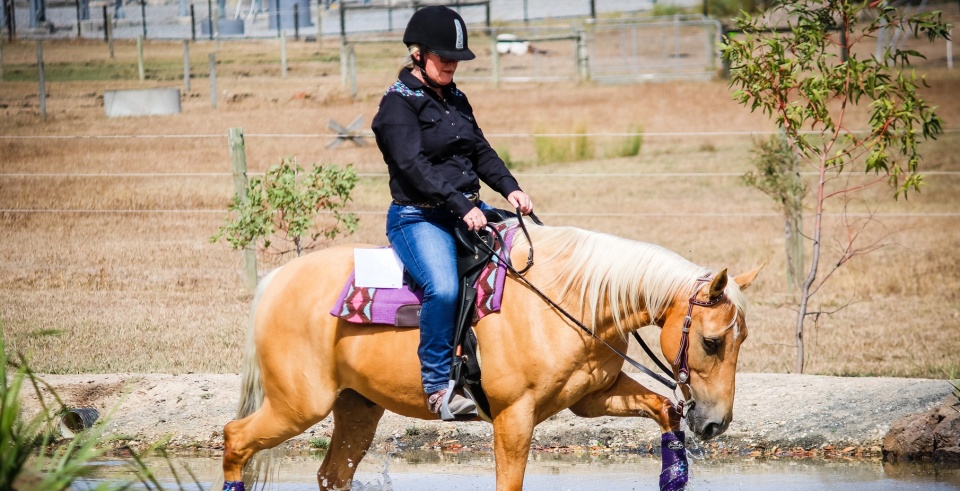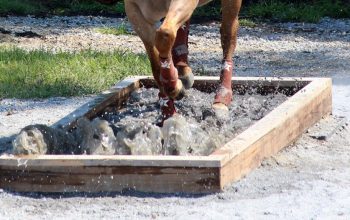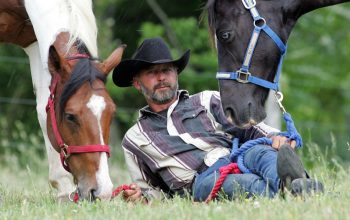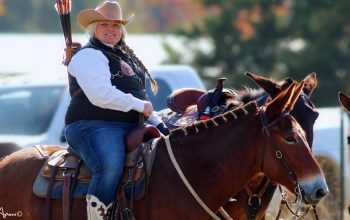
By Mark Bolender
Spring is almost here, and the trails are calling. Enjoyment, beauty and adventure are on the horizon! For many of us, snow, ice and subzero temperatures have kept us off the trail for months and our excitement for getting back on the trail is building. For the ride to go well, our horses need to be prepared. Trail preparation doesn’t have to be difficult and isn’t as scary as it sounds. With a few simple tips, you can incorporate training on trail obstacles into your routine and be ready to go.
Cost Effective Preparation
Trail preparation doesn’t require a monetary investment or even construction skills, just a little bit of ingenuity. A very simple but effective trail obstacle can be constructed from cord wood. Take approximately one-half cord of wood and place it in a 12 by 30-foot area. The cord wood should be randomly placed yet with enough spacing for you to walk through. If you can walk through it, so can the horse. Don’t have cord wood? Take a walk in the woods and see what you can find. You can also do this with a rock patch. Both are very inexpensive and effective for training for your spring tune-up.
Start from the Ground
I’m a firm believer that a great ride and good horsemanship starts from the ground. With the obstacles in place, start training from the ground. Driving is the ability to move the horse ahead of you through obstacles. While this technique is considered a basic horsemanship skill it does take practice and patience.
Begin by driving the horse forward over the obstacle. Resist the urge to lunge the horse or it will jump. Instead. Have your horse slowly walk up to the obstacle and allow it to drop its head to inspect it. Here is the easy part, yet most handlers often overlook it. Give the horse time to think. Don’t pressure it, as I’m a firm believer that a great ride and good horsemanship starts from the ground. With the obstacles in place, start training from the ground. Driving is the ability to move the horse ahead of you through obstacles. While this technique is considered a basic horsemanship skill it does take practice and patience.

Begin by driving the horse forward over the obstacle. Resist the urge to lunge the horse or it will jump. Instead. Have your horse slowly walk up to the obstacle and allow it to drop its head to inspect it. Here is the easy part, yet most handlers often overlook it. Give the horse time to think. Don’t pressure it, as long as it’s on task.
Is My Horse Engaged?
Beginners often ask, “How do I know my horse is engaged in the obstacle?” There are a number of key signs. Often a horse will drop its head in order to inspect the obstacle that you want it to navigate. Your horse may snort, paw the ground or even the object. Ears are forward and/or moving back and forth and lips may be moving. Sometimes horses shake, tighten up around the mouth and if panicked, try to run you over. Watching your horse’s eyes gives you signs of engagement, concentration or panic. Your job is to stay safe with your clear and consistent directions while keeping your horse focused on the obstacle.
Stay Focused
The horse’s instinct will be to read every move you make so stay focused and move your feet as little as possible. If your signals are not clear to the horse its instinct will prevent it from trusting you and it will not properly move through the obstacle. If you keep your emotions in check, stay focused, and give clear signals you will soon find the horse will walk over or through the obstacle in a safe, thoughtful manner and it will begin to trust you.
Start Simple
Your goal is to have the horse relax and think and become your partner. Most horses will rush through an obstacle in an unsafe manner, which is potentially dangerous for both handler and horse. That is why it’s important to start with simple obstacles and build up to the more difficult ones. If the horse rushes through, stop it and ask it to think. It’s normal for a horse to rush through, so don’t be discouraged. Just be patient and ask it to navigate the obstacle again until it walks in a safe manner.

Build Your Horse’s Boldness and Confidence
Walking over or through obstacles is the best way to prepare your horse for the trail because it will build boldness and confidence. As this occurs, and when the horse can walk over the logs or through the obstacles without incident, it is then time to ride. Practice riding a few times before hitting the trail and you’ll be able to simply enjoy the beauty of the trial ride.
Pony a Horse
I should point out that another method I like to use is to pony a horse. However, that takes a having a seasoned and trustworthy horse in addition to possessing riding and rope skills. Ponying is great because some horses are very good at instilling confidence in another horse while being led from the other horse. By ponying, the horse is being introduced to various obstacles, and you can build a trail horse that’s a joy and safe to ride.
The cover photo: Kathy Dalladay and Pilgrim – Avalon Horse Park, Victoria Australia. Photo by Chloe Dann





